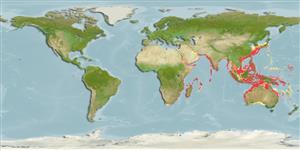>
Carangiformes (Jacks) >
Carangidae (Jacks and pompanos) > Caranginae
Etymology: Decapterus: Greek, deka = ten + Greek, pteron = wing, fin (Ref. 45335).
More on author: Rüppell.
Environment: milieu / climate zone / depth range / distribution range
Ecologie
marien benthopelagisch; diepte 40 - 275 m (Ref. 12260). Tropical; 40°N - 36°S, 18°E - 172°E
Indo-West Pacific: East Africa to Japan, the Arafura Sea (Ref. 9819) and Australia. A Lessepsian migrant (Ref. 72453).
Lengte bij maturiteit / Grootte / Gewicht / Leeftijd
Maturity: Lm 16.1, range 14 - 24.5 cm
Max length : 45.0 cm TL mannelijk / geslacht onbekend; (Ref. 9987); common length : 30.0 cm TL mannelijk / geslacht onbekend; (Ref. 9987); max. gepubliceerd gewicht: 110.00 g (Ref. 4883); max. gerapporteerde leeftijd: 12 Jaren (Ref. 5406)
Dorsale stekels (totaal) : 9; Dorsale zachte stralen (totaal) : 28 - 31; Anale stekels: 3; Anale zachte stralen: 25 - 28; Wervels: 24. Lateral line curved below soft dorsal and with 30-44 strong scutes; color bluish green above, silvery below; caudal fin hyaline to yellowish; dorsal fins hyaline basally, light dusky distally. Opercle with small, black spot; opercular membrane with smooth margin. Snout longer than eye diameter; squarish lower posterior edge of maxilla; upper jaw with small teeth anteriorly; soft dorsal and anal fins relatively low, not falcate; pectoral fin sub falcate. (Other source of data on morphology: Refs. 3131, 3197, 3287).
Adults dwell from middle to benthic (Ref. 11230), forming large schools in deep water, but occasionally inshore in sheltered bays in small to large groups (Ref. 48635). The most common Decapterus in coastal waters and on open banks of the Indian Ocean. They feed mainly on smaller planktonic invertebrates. Generally marketed fresh, may be dried or salted. Also sold frozen and canned (Ref. 9987).
Paxton, J.R., D.F. Hoese, G.R. Allen and J.E. Hanley, 1989. Pisces. Petromyzontidae to Carangidae. Zoological Catalogue of Australia, Vol. 7. Australian Government Publishing Service, Canberra, 665 p. (Ref. 7300)
Status op de Rode Lijst van het IUCN (Ref. 130435)
Gevaar voor de mens
Harmless
Gebruik door de mens
Visserij: van groot commercieel belang; aas: occasionally
Tools
Speciale rapporten
Download XML
Internetbronnen
Estimates based on models
Preferred temperature (Ref.
123201): 16.8 - 27.4, mean 23.2 °C (based on 690 cells).
Fylogenetische diversiteitsindex (Ref.
82804): PD
50 = 0.5010 [Uniqueness, from 0.5 = low to 2.0 = high].
Bayesian length-weight: a=0.01047 (0.00917 - 0.01196), b=2.96 (2.93 - 2.99), in cm total length, based on LWR estimates for this species (Ref.
93245).
Trofisch niveau (Ref.
69278): 3.7 ±0.4 se; based on diet studies.
Generation time: 1.5 (1.2 - 1.7) years. Estimated as median ln(3)/K based on 28
growth studies.
Weerstandsvermogen (Ref.
120179): Gemiddeld, minimale populatieverdubbelingstijd 1,4-4,4 jaar (K=0.2-1.4; tm=3; Fec=20,000; tmax>3).
Prior r = 0.68, 95% CL = 0.45 - 1.03, Based on 16 data-limited stock assessments.
Fishing Vulnerability (Ref.
59153): Low vulnerability (24 of 100).
Climate Vulnerability (Ref.
125649): Moderate vulnerability (42 of 100).
Nutrients (Ref.
124155): Calcium = 394 [150, 1,297] mg/100g; Iron = 3.4 [1.2, 8.1] mg/100g; Protein = 19.4 [18.0, 20.9] %; Omega3 = 0.359 [0.161, 0.825] g/100g; Selenium = 148 [46, 441] μg/100g; VitaminA = 10.8 [2.3, 46.9] μg/100g; Zinc = 1.31 [0.73, 2.52] mg/100g (wet weight); based on
nutrient studies.
